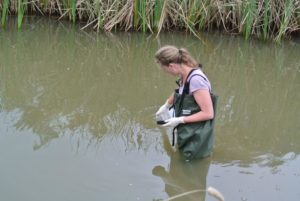Estimating species’ rank abundance by improving eDNA techniques

Elise collecting a water sample from mid-stream.
Environmental DNA (eDNA) is rapidly increasing in popularity as a molecular detection tool to identify species from substrates such as soil or water. Combined with metabarcoding, eDNA can provide rapid, high throughput detection of multiple species from a single environmental sample. Currently eDNA metabarcoding studies focus on detecting the presence of taxa and have been used to inform species distributions and community composition. The ability to decipher the relative abundance of taxa could greatly increase the application of the technique to ecological management. Unfortunately, the ability of metabarcoding to provide quantitative information is currently limited due to a number of technical constraints leading to differential amplification between DNA fragments.
This project will investigate the factors that lead to biases in DNA amplification and the degree to which they influence the final results. Knowledge of the cause of these biases can assist with developing controls or standardization techniques to apply to metabarcoding approaches to improve estimates of relative abundance of taxa within a sample.
Project Lead: Dr Elise Furlan (Environomics FSP Postdoctoral Fellow)
A complimentary project led by Xin-Yi Chua, Bioinformatic methods for estimating animal abundance from eDNA, is focussed on developing new bioinformatic methods for obtaining quantitative information on animal abundance and biomass from eDNA datasets.
